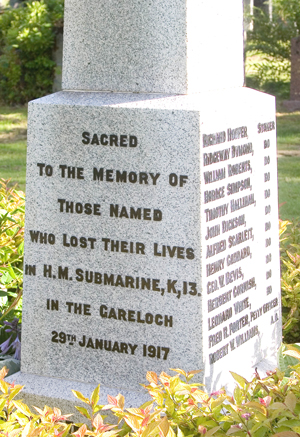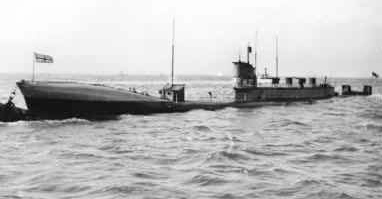ONE of the saddest events in the history of the Gareloch is the K13 submarine disaster, which took place on January 29 1917.
What follows is the first of four accounts of the tragedy, this one by courtesy of the Submariners Association website.
The gargantuan K class steam submarines (one is pictured right) were treated as a joke by the hardened veterans of the Submarine Service when they first appeared.
But that fateful afternoon they suddenly developed a new and more sinister reputation. From that day onwards 'K' stood for Killer. And by apt coincidence the drama featured no.13.
K-13 was carrying out her final acceptance trials prior to the Admiralty officially taking her over from her Clydeside builders, Fairfields.
She had already covered the measured mile at a record 23 knots to gain the honour of the world's fastest submarine and there was a festive air about the pre-diving lunch which continued to 3.15 pm.
As she glided slowly down to the diving area in Gareloch she was carrying not only her regular crew of 53 officers and men but also 14 directors and employees of Fairfields, 13 other civilians, and two Royal Navy submarine officers acting as observers to gain K-boat experience. When she arrived at the loch she picked up two more civilian experts.
She dived smoothly enough but to Lieutenant Commander Godfrey Herbert's consternation she refused to trim level at 20 feet and continued plunging toward the bottom.
An ERA reported the boiler room to be 'flooding down' and the watertight door to the stern section was promptly closed and locked. It was a drastic remedy, but if the submarine was to be saved there was no alternative even though it meant certain death for the men trapped in the compartments aft of the engineroom bulkhead.
The hydroplanes moved to 'hard a'rise' and compressed air screamed through the pipes as the ballast tanks were blown clear of water. But K-13 showed no desire to surface, and in a desperate effort to avoid disaster Lt. Cdr. Herbert dropped the forward 10-ton keel.
Even this failed to stop the submarine's crazy dive and moments later her stern settled on the muddy bottom of the loch in 50 feet of water. And as if to compound her crew's misfortunes, the main switchboard caught fire and consumed valuable oxygen before the men managed to beat out the flames with their bare hands.
Thirty-one of the men aboard the ill-fated submarine were already dead — trapped and drowned in the flooded stern section. Only one watertight door separated the remaining survivors from a similar death, or perhaps even worse.
Professor Percy Hillhouse, the naval architect who had embarked at the loch shortly before the fatal dive, was busy with his slide-rule calculating how much air was left and how long it would last. It was not an encouraging answer — only eight hours at most.
The confusion at the surface was, if anything, greater than the dark despondency of the men trapped below. Although the escorting tug wirelessed an urgent message reporting a probable disaster within an hour of K-13's disappearance, it was a full six hours before a gunboat and two salvage tugs left the Clyde, and by then seven of the predicted eight hours had gone.
Gossamer arrived at midnight with a diving suit, but no diver. When one was finally found the suit proved to have perished with age and nearly drowned its unfortunate occupant. Thrush arrived on the scene shortly afterwards but she had neither suit nor diver.
Finally however, one of Fairfield's civilian divers went down and, groping his way along the sunken hull, he made contact with the trapped men by tapping Morse messages on the plating.
Aware that time was running out Lt. Cdr. Herbert decided to send one of the officer passengers, Captain Goodhart, D.S.O., who was captain of the note yet completed K-14, to the surface by flooding the conning-tower and blowing him upwards in a bubble of compressed air. It was a risky business and Herbert personally supervised the escape attempt.
The two men climbed into the conning-tower, closed the lower hatch, and opened the valves so that the compartment slowly flooded and compressed the air inside it. When the water level reached their waists K-13's skipper released the submarines own high pressure air and clung to the steel supports while Cpt Goodhart pulled the clips and opened the upper hatch.
The tremendous surge of compressed air caught both men unaware. Cpt Goodhart streaked upwards through the hatch as planned but moments later, Lt. Cdr. Herbert found himself being swept up as well. As it happened he was lucky.
The men standing on Thrush's deck saw a confused upheaval of water as the air rushed to the surface and Lt. Cdr. Herbert's head suddenly bobbed into sight. Strong arms grabbed him and, more dead than alive, he was dragged aboard the tug. But the gallant Cpt. Goodhart never made it. Caught up in the rush of escaping air, he was hurled against the roof of the bridge, knocked unconscious, and drowned.
Now that the skipper was safely on the surface there was renewed hope for the men trapped below.
His unriva lled knowledge of K-13's structure and his first-hand report of conditions inside the doomed submarine at least gave the salvage experts something to work on. Unfortunately it also gave them something to argue about and more precious minutes slipped by.
lled knowledge of K-13's structure and his first-hand report of conditions inside the doomed submarine at least gave the salvage experts something to work on. Unfortunately it also gave them something to argue about and more precious minutes slipped by.
It was agreed, however, that the first priority was to supply air to the sunken submarine to keep the men alive, and, of equal importance, air which, as the pressure built up, would support the leaking engineroom bulkhead — the only thing separating the survivors from disaster.
High pressure hoses were taken down but the divers were unable to find any way of connecting them to K-13's hull. It was six o'clock the following evening — long past Prof. Hillhouse's deadline — before the pipes were secured.
Then it was found that no air was getting through. More discussions followed and, while the experts argued and wrangled over the problem, the divers picked up more Morse signals from the trapped men: “Give us air. Give us air.”
By midnight the fault was traced to an ice blockage in the line itself and within minutes fresh pure air was being pumped into the poisoned hull to revive the half dead survivors. A further tube was used to send food down, and by 6.30 a.m. voice communication had been established.
Yet despite the renewed hopes of the rescuers, the salvage experts continued to argue. A steel wire was latched under K-13's ungainly hull and slowly, creaking with strain, the forward end of the submarine was lifted inch by inch until the bows were standing clear of the surface.
Seizing his opportunity Lt. Cdr. Herbert decided to bring the survivors out through the torpedo tubes, but before this could be done, K13 lurched, slid back slightly, and came to rest with the bottom of the tubes two tantalising inches below the surface.
For the trapped men disappointment deepened into bitter despondency when the fuses of the main switchboard blew, and except for a few hand torches, the interior of the submarine plunged into total darkness.
Finally, after hours of argument the experts accepted the skipper's alternative suggestion to cut a hole in the bows with an oxy-acetylene torch. Even this took valuable time, for the space between the outer and inner casings was found to be flooded and the exhausted men inside the submarine had to pump the area clear.
But Lt. Cdr. Herbert's determined perseverance won in the end and, just after 3 p.m., 57 hours after K13 had started her fatal dive beneath the surface of Gareloch, the 46 survivors were helped through the escape hole to a miraculous return from death.
 The submarine was finally salvaged on March 15, repaired, and recommissioned as K-22 (right). She was eventually sold for scrap in December 1926 in Sunderland.
The submarine was finally salvaged on March 15, repaired, and recommissioned as K-22 (right). She was eventually sold for scrap in December 1926 in Sunderland.
In Faslane Cemetery stands the K13 Memorial (above left), a simple grey granite obelisk set among the graves, to the Royal Navy and shipyard personnel who drowned in the disaster. The shipyard personnel graves are in a small group closer to the cemetery gateway.
Another memorial stands in the David Elder Park, Govan, next to the shipyard where the workers came from.
There is a memorial to the disaster in Carlingford, New South Wales, Australia, paid for by the widow of Charles Freestone, a Leading Telegraphist on the K-13, who survived the accident to later emigrate and prosper in Australia.
This memorial was unveiled on September 10 1961 and has the inscription: "This memorial has been created in memory of those officers and men of the Commonwealth who gave their lives in submarines while serving the cause of freedom. It is called the K-13 memorial in particular memory of those lost in HM Submarine K-13."




